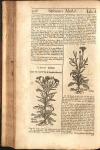

 I. The Names. They are called in Latin Cyanus multiflorus: and in English, Double-flowred Blew-bottle, or Corn-flower.
I. The Names. They are called in Latin Cyanus multiflorus: and in English, Double-flowred Blew-bottle, or Corn-flower.
II. The Kinds. They are of the lesser Kind of Blew-bottle, and are twofold,
- 1. Cyanus caeruleus multifiorus, Double Blew-flowred Blew-bottle, or Corn-flower. (Centaurea cyanus. -Henriette.)
- 2. Cyanus purpureus multiflorus, Double Corn-flower Purple-flowred. (Centaurea cyanus. -Henriette.)
- 3. To these we add, Cyanus floridus Turcicus, Cyanus floridus odoratus Turcicus, Cyanus Orientalis, which is also Major and Minor. The Turky Blew-bottle: The Turky Sweet-scented Blew-bottle, and the Sultan's Flower, because the Grand Senior espying it as he was walking abroad, liked it, and wore it himself, for which reason his Vassals held it in great esteem: of this there is a Greater and a lesser. (Amberboa moschata. -Henriette.)
III. The Description. The first of these differs not at all from the small Field Corn-flower in the former Chapter, neither in the Roots, Stalks, Leaves, nor Seeds, but only in the Flowers, for that the Flowers of this Plant, are of a fair Blew color, and very double, whereas the other are single.
IV. The Second of these is also like unto the former in all respects, saving in the color of the flower; for whereas that is double, and of a fair blew; the flowers of this are also double, and of a bright purple color.
V. The Third is a Plant or Flower of much beauty: It has a Root like the other Blew-bottles, which perishes every Year; the Leaves hereof are not much greener, but larger, and more gashed in on the edges; the Stalks are three feet high at least, and lower than in the other, beset with the like Leaves, but smaller, and branching into several parts, each of them bearing a larger scaly head than the former, and biger in the Greater of this kind, than in the lesser, with Blew-bottle like flowers, but larger, and consisting of eight or nine hollow Leaves, with wider open brims, and small, pale or almost white threads in the middle; the circling Leaves are of a fine beautiful purple color, very glorious to behold. This Flower is of so exceeding a sweet scent, that it supasses (says Parkinson) the best Civet that is. The Seed is blackish, and enclosed in a Downy substance like the former.
VI. The Places. The two first are often found in Corn fields, and are also nourished up in Gardens. The last was brought to us from Turkey, or Constantinople, and grows in the Gardens of some Herborists.
 VII. The Times. They flower for the most part thro' all the Summer, and their Seed ripens in the mean season.
VII. The Times. They flower for the most part thro' all the Summer, and their Seed ripens in the mean season.
VIII. The Qualities, Specification, Preparations, Virtues and Uses, are all exactly the same with those in the former Chapter, so that we shall say no more thereof in this place.
Botanologia, or The English Herbal, was written by William Salmon, M.D., in 1710.
This chapter has been proofread by Nick Jones.

